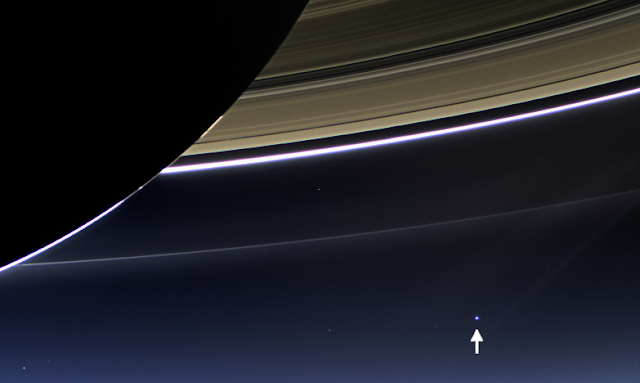 |
| Earth seen from Saturn. Image Credit: NASA/JPL-Caltech/Space Science Institute |
While we wait for what will certainly be some important World Youth Day eco-messages from Hurricane Francis (as Alejandro Bermudez at the National Catholic Register so wonderfully called him), we would do well to pull our view back for an historic perspective—one about 900 million miles away.
Recently released images from NASA’s Cassini spacecraft
show Earth and our moon from a never-before-seen vantage: from orbit around Saturn.
The photos are stunning and, I think, reassuring. Even if our world looks tiny,
the view from the sixth planet has much to say about the dignity of human life
and of all life on Earth.
But some commentators have tended toward a different take on all this—a telling
one because it can sound dismissive of human existence.
 |
| Image Credit: NASA/JPL-Caltech/Space Science Institute |
London’s The Daily Mail headlined their story describing
Earth as “[j]ust one small dot.” Michael Zennie, the piece’s author, noted that
“Earth appears as an insignificant-looking pale blue dot below Saturn's
majestic rings ...”
John Van Randowitz said much the same in his AAP piece from
Australian News.
Nick Mediati, at Techhive.com, pondered if this all made you feel “insignificant” (there’s that word again). He adds,
It's simultaneously stunning and a little depressing, actually, to think that you exist on nothing more than a tiny, pale dot. Like ants on the sidewalk, almost.
Certainly there was much awe and joy expressed by these and other journalists,
bloggers, scientists and regular folk being interviewed. But the undertone of insignificance
by so many should trouble us.
 |
| Image Credit: NASA |
It is also odd that these images didn’t have the effect on
the human race as did the first images of Earth seen from the moon in the
1960s. Those shots brought much jubilation. Perhaps so few enthusiastically received the images from Cassini (a spacecraft
named after Giovanni Domenico Cassini, a Catholic astronomer) because so many of us are losing a sense of
wonder and awe at what exists beyond our own worlds.
A lack of appreciation for our place in creation does not occur in the Catholic Mass. Especially when the priest elevates the
Eucharist for all to see—and when all believers see it and sing their great
Amen—the entire congregation (and everyone in Communion with them, on earth and
in heaven) share a brief moment of union with God, with each other, and with the cosmos. This includes
Saturn, the entire solar system, and all space, time, and matter that twirl
about in God’s great creation like farmers at a mid-summer’s barn dance. Nothing in creation, especially life, is insignificant—no matter the perspective.
In his Apostolic Exhortation Sacramentum Caritatis, (The
Sacrament of Charity), Pope Benedict XVI put it this way:
Christian people, in giving thanks to God through the Eucharist, should be conscious that they do so in the name of all creation, aspiring to the sanctification of the world and working intensely to that end.
[t]he liturgy itself teaches us this, when, during the presentation of the gifts, the priest raises to God a prayer of blessing and petition over the bread and wine, "fruit of the earth," "fruit of the vine" and "work of human hands." With these words, the rite not only includes in our offering to God all human efforts and activity, but also leads us to see the world as God's creation, which brings forth everything we need for our sustenance. The world is not something indifferent, raw material to be utilized simply as we see fit. Rather, it is part of God's good plan, in which all of us are called to be sons and daughters in the one Son of God, Jesus Christ (cf. Eph 1:4-12)
 |
| Image Credit: NASA/JPL-Caltech/Space Science Institute |
From a Catholic perspective, the images from Cassini do not minimize
Earth—or its ecosystems or its inhabitants. They remind us that humanity’s
physical home is nothing less than the entire universe itself.
And so anyone who appreciates what the Eucharist offers all creation will not feel a tad insignificant when viewing Cassini’s pictures. They will feel awe. Indeed, with this view, one will more likely value the goodness of all creation and all life—especially human life (born and unborn) and the ecosystems that support human life.
And so anyone who appreciates what the Eucharist offers all creation will not feel a tad insignificant when viewing Cassini’s pictures. They will feel awe. Indeed, with this view, one will more likely value the goodness of all creation and all life—especially human life (born and unborn) and the ecosystems that support human life.
As Benedict XVI noted in
the conclusion of this section in Sacramentum Caritatis,
The relationship between the Eucharist and the cosmos helps us to see the unity of God's plan and to grasp the profound relationship between creation and the "new creation" inaugurated in the resurrection of Christ, the new Adam.
And so next time you receive Communion, think of the images
from the Cassini spacecraft and remember that the Person you have just received
within you is responsible for creating and holding together the entire universe—and none of it would be the same without you.
What a beautiful reflection, thank you for sharing it!
ReplyDeleteLovely post. You might find Al Kresta's book, Dangers to the Faith, http://j.mp/OSVKrestaDTF to be interesting. He talks about Reductionism, where man and the Earth is just reduced by people as nothing but "glorified apes" etc. where people share X% of their DNA with worms or mice, etc. It reduces man to intelligent chemicals but never including the soul, or being as part of God's plan.
ReplyDelete